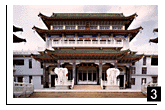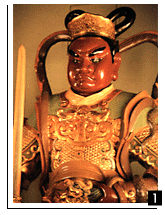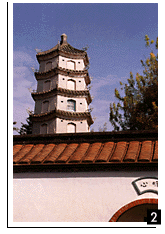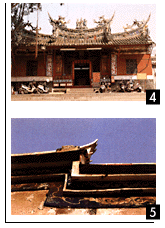¢xAncient Ming Tombs¢xAn-Ping Settlement¢xArtillery Fortifications¢xBuddhist Monasteries¢xCity God Temple¢xCity Walls & Gates¢xConfucian Temple¢xFamily Shrines¢xForeign Merchant Houses¢xFort Provintia¢xFort Zeelandia¢xHistorical Wells¢xHistorical Western Style Architecture¢xHouses & Gardens¢xKoxinga's Shrine¢xMartial Temples¢xMedical God Temples¢xMemorial Stone Gates¢xPantheon of Universal Deities¢xPresbyterian Architecture¢xTemple of the Five Concubines¢xTemples of Heavenly Holy Mother¢xTemples of Supreme Emperor of Dark Heaven¢xVegetarian Halls¢x
Buddhist Monasteries
 In
the seventeenth century, Buddhism was introduced into Taiwan and many Buddhist
monasteries were built in Tainan, Kai-Yuan,Fa-Hua, Chu-Si, Mi-Ton, Chong-Ching
Szu was demolished completely. Chong-Ching Szu and Long-shan Szu were relocated
and Chu Si and Mi-Tou were rebuilt. Kai-Yuan Szu and Fa-Hua Szu still retain
their original look.
In
the seventeenth century, Buddhism was introduced into Taiwan and many Buddhist
monasteries were built in Tainan, Kai-Yuan,Fa-Hua, Chu-Si, Mi-Ton, Chong-Ching
Szu was demolished completely. Chong-Ching Szu and Long-shan Szu were relocated
and Chu Si and Mi-Tou were rebuilt. Kai-Yuan Szu and Fa-Hua Szu still retain
their original look.
Established in 1680 by Chang Ching for his mother, kai-Yuan Szu, listed as a Grade IIhistorical landmark, was a home name Pei-Yuan Pieh-Kuan Which was donated to be a Buddhist monastery in 1690 and called Hai-Hui Szu in which Sakyamini is worshipped as the main deity. It preserved original structure at the front hall and the main hall after several reconstructions. The status of Happy Buddha, Sakyamini and Four Great Heavenly Kingo are of religious and artist importance.
 Originally
the residence of Meng-Deh Yuan (Garden of Butterfly Dreaming), Fa-Hua Szu was
built by lee Mao-Chun During the Dynasty of Ming. Fa-hua was built aside the
house in 1684 to worship Sakyamini and destroyed during World War II. It was
rebuilt after the war and preserved the great portraits of Four Great Heavenly
Kings and mural paintings by folk artist Pan-Li-Shui. The paintings and the
tombstone of Lee Mao-Chun are valued artifact.
Originally
the residence of Meng-Deh Yuan (Garden of Butterfly Dreaming), Fa-Hua Szu was
built by lee Mao-Chun During the Dynasty of Ming. Fa-hua was built aside the
house in 1684 to worship Sakyamini and destroyed during World War II. It was
rebuilt after the war and preserved the great portraits of Four Great Heavenly
Kings and mural paintings by folk artist Pan-Li-Shui. The paintings and the
tombstone of Lee Mao-Chun are valued artifact.
During
the Yung-Li period of the Ming Dynasty, Chu-His Szu was built and reconstructed
in Chinese style in 1973. Ta Kuan-Yin Ting and Wan-Fu An also possess their
Buddhist characteristics except orthodoxy Buddhist monasteries. Founded in 1678,
Ta Kuan-Yin Ting (Great Pavilion of Goddess of Mercy) was the largest temple in
Taiwan that worships this particular goddess. Kuan-yin is the embodiment of
loving kindness and source of help in time of need and is especially popular
among women and the elder people. The temple, Grade III historical landmark,
preserved many valued historical treasurers. Yeh-Hsia Lao-Jen (Marriage God) is
always mentioned among many other deities in the temple.
Ting (Great Pavilion of Goddess of Mercy) was the largest temple in
Taiwan that worships this particular goddess. Kuan-yin is the embodiment of
loving kindness and source of help in time of need and is especially popular
among women and the elder people. The temple, Grade III historical landmark,
preserved many valued historical treasurers. Yeh-Hsia Lao-Jen (Marriage God) is
always mentioned among many other deities in the temple.
Originally build during the Yung-Liperiod of the Ming Dynasty and reconstructed in 1806, Wan-Fu An (Covert of Endless Fortune) lost it's traditional look after a recent renovation. It is listed as a Grade III historical landmark.
¢xAncient Ming Tombs¢xAn-Ping Settlement¢xArtillery Fortifications¢xBuddhist Monasteries¢xCity God Temple¢xCity Walls & Gates¢xConfucian Temple¢xFamily Shrines¢xForeign Merchant Houses¢xFort Provintia¢xFort Zeelandia¢xHistorical Wells¢xHistorical Western Style Architecture¢xHouses & Gardens¢xKoxinga's Shrine¢xMartial Temples¢xMedical God Temples¢xMemorial Stone Gates¢xPantheon of Universal Deities¢xPresbyterian Architecture¢xTemple of the Five Concubines¢xTemples of Heavenly Holy Mother¢xTemples of Supreme Emperor of Dark Heaven¢xVegetarian Halls¢x